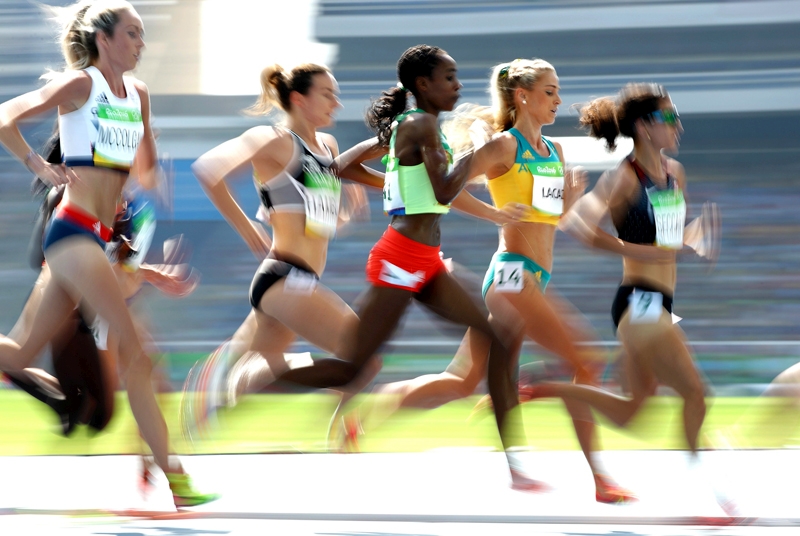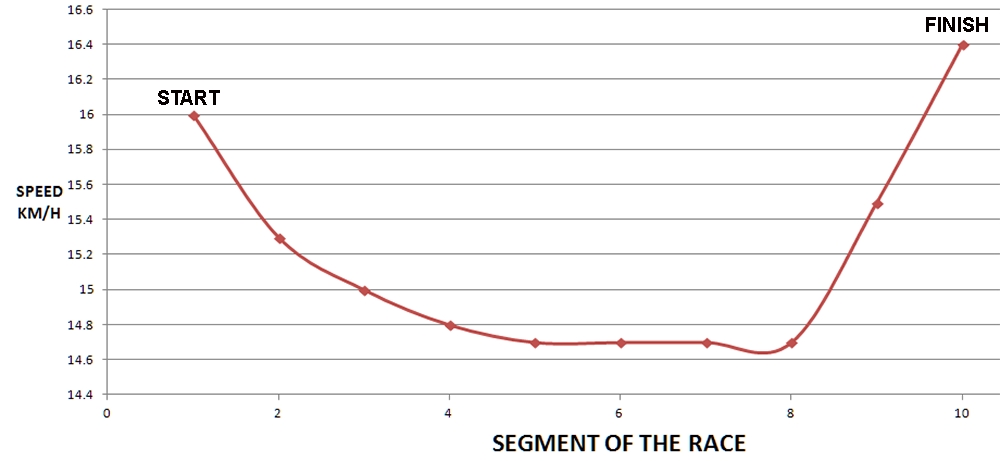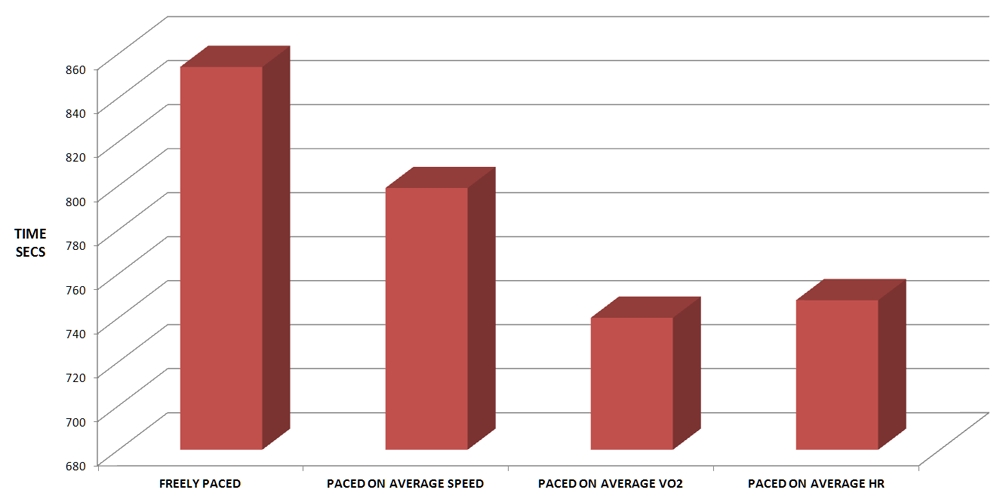Race pacing: free choice or follow the rules?

SPB looks at new research on endurance event pacing; is it really true that a freely-chosen pace works best?
How best to pace an endurance event is a perennial question for athletes such as runners, swimmers, cyclists and rowers. Many athletes simply pace themselves on an “I’ll see how I feel on the day” basis. Others find out what has worked well for them in the past and stick with that. Some athletes take a more data-driven approach and use information garnered from previous training sessions to help then decide on what strategy might work best for them in any particular event. Athletes with coaches meanwhile will often just follow their instructions in the hope that ‘coach knows best’!Central governor pacing
While all of the above strategies are undoubtedly popular among athletes, it turns out that the science of optimal pacing is rather more complex, and a topic of fierce debate among sports scientists themselves. To complicate matters further, there have been relatively few systematic studies of how various pacing strategies influence the outcome of competitive results. However, over the last 20 years, researchers have proposed that psychology and brain input plays a major role in how athletes pace themselves during competitive events. In particular, maximal exercise intensity is largely modulated by when the athlete expects the exercise bout to end, with athletes ensuring they don’t blow up before the race is finished(1,2).This ‘brain control’ of pacing is the key tenet of the ‘Central Governor Theory’ (see this article). Originally proposed by Professor of Exercise Physiology and running guru Tim Noakes, the thrust of the Central Governor theory is that the brain uses a mixture of conscious, sub-conscious and physiological cues to control the muscles and hold them back from reaching the true brink of exhaustion. In other words, physiological factors (such as the level of muscle glycogen, lactate etc) are not the direct cause of fatigue, but just some of many signals that the brain takes into account along with other information, to set the level of fatigue you actually experience. According to the theory, the brain is constantly monitoring the situation and when it decides you’ve had enough, it creates the distressing sensations, which you then interpret as muscle fatigue.
In line with the Central Governor paradigm of exercise and performance, it is unsurprising that ‘free pacing’- ie where the athlete varies the pace according to his/her sensations of effort and fatigue - is currently considered to be key to optimizing performance(3). In a race of course, it’s not just the athlete’s sensations of fatigue that counts, it’s also what the other competitors are doing! Therefore, choice of the speed variations that can maximize the endurance athlete’s ability to win a race involves a complex interplay between physiological and psychological factors(4).
The evidence for variable pacing
When looking at the actual pacing data from past races, there’s good evidence that a variable and free-pacing strategy, where the athlete saves something in reserve for the finish, is indeed a widely used strategy. For example, a 2019 analysis of the pacing strategies used by runner in almost 300 marathon races (a lot of data!) showed that variable pacing is very common and that when runners adopted a ‘positive speed asymmetry’, this was associated with better performance(5). One of the most popular examples of positive speed asymmetry is the ‘bathtub-shaped’ curve, in which the runner spends around two-thirds of the total duration of the race below his/her overall average speed (ie after a fast start, the pace drops somewhat only to be increased again during a fast finish – see figure 1).Figure 1: Typical positive-speed ‘bathtub-shaped’ curve

After a fast start, the athlete spends around two thirds of the time running at slower than overall average pace before speeding up significantly at the end.
Is there a better way?
While a variable pacing strategy driven by an interplay of psychological and physiological factors is undoubtedly popular, some scientists have queried this approach by asking if an athlete could manage to minimize physiological strain by maintaining a constant and optimum pace, surely this would feedback into the overall control system and therefore reduce the need for pacing variation? Now new research to try and answer this question has recently been published by the famous French researcher Veronique Billat (the creator of Billat intervals – see this article), and which appears in the International Journal of Environmental Health and Public) Health(6).In this study, Billat and her researchers compared four different pacing strategies in terms of performance during 3000m running. Eight trained, non-elite runners were enrolled in the study and completed four separate 3000m time trials on four separate occasions, each trial separated from the last by at a time period of 3-7 days. For the initial trial (TT1), all the runners ran as fast as possible using a freely-chosen pace. The total trial time was measured using a stopwatch. This initial (TT1) trial was the reference trial from which the control variables applied to the following three trials (performed in random order) were determined. The next three trials (TT2, TT3 and TT4) consisted of the following:
- In the TT2 trial, each runner had to maintain a steady-state corresponding to the average speed they had achieved in TT1.
- In the TT3 trial, each runner had to maintain a steady-state oxygen uptake (VO2), which corresponded to their average value recorded during TT1.
- In the TT4 trial, each runner had to maintain a steady-state heart rate (HR) corresponding to their average value recorded in TT1.
The findings
When the data was number crunched, the key finding was that the freely-chosen (varying) pace did NOT produce the fastest times, and neither did the average paced trial based on the freely-chosen pace. The actual 3000m times averaged across the runners were as follows (see figure 2):- Freely paced – 854 seconds
- Paced on average speed (of TT1 trial) – 799 seconds
- Paced on average oxygen uptake of TT1 trial – 740 seconds
- Paced on average heart rate of TT1 trial – 748 seconds
Figure 2: Average 3000m times for the four different pacing strategies

When the runners paced themselves by sticking to their average oxygen uptake or average heart rates recorded in the freely chosen 3000m time trial, their times improved by up to 115 seconds!
Practical implications
The main finding in this study is that a free pacing strategy for a middle-distance running time trial was far from optimal in non-elite runners. In short, a spontaneously chosen pace does not seem to enable the non-elite runner to maximize performance or minimize physiological strain. This finding validates the criticism of the Cooper running test (how much distance can be covered in 12 minutes) to assess fitness – namely that it penalizes less experienced runners because the alternation of running and walking was possible, and the choice of pace is left to the runner(7).In the context of middle-distance running (races ranging from over 1,500m to 10,000 m, lasting between 4 and 15 minutes), the pace is generally not constant. Therefore the use of pacing according to a predetermined oxygen uptake or heart rate might induce an ideal pacing pattern (or at least one that is significantly better than freely chosen pace). Of course, for experienced and more elite runners with extensive experience of self pacing, sticking a predetermined pace based on oxygen consumption or heart rate may produce little or no gains over a freely-chosen pace. After all, one of the main benefits of racing experience is the ability to pace oneself better.
For amateur runners however, using a predetermined pace based on average heart rate or oxygen uptake in a previous ‘best-effort’ performance could be a good place to start. Of these two physiological variables, heart rate data is obviously much easier to use; a decent heart rate monitor that can collect this data and provide athletes with the average over a given time period is relatively inexpensive and very easy to use, especially compared to oxygen uptake monitoring. To achieve this, less experienced athletes can simply wear an accurate and good quality heart rate monitor while performing a time trial a week or two prior to the event but over the same race distance. The average heart rate is the calculated (by the software) from the data and that is used to set the pace for the event. Don’t forget too that when pacing by following a predetermined heart rate, it is still possible to up the pace and finish with a sprint at the end of the event, thus improving performance still further!
References
- PLoS One. 2008 Aug 13; 3(8):e2943
- Sport Psychol. 2012;26:359–374
- Front Physiol. 2012; 3():82
- J Appl Physiol (1985). 1999 Aug; 87(2):853-61
- Phys. Stat. Mech. Appl. 2019;515:240–247
- Int J Environ Res Public Health. 2021 Aug; 18(15): 7886
- Res Q. 1973 May; 44(2):206-15
You need to be logged in to continue reading.
Please register for limited access or take a 30-day risk-free trial of Sports Performance Bulletin to experience the full benefits of a subscription. TAKE A RISK-FREE TRIAL
TAKE A RISK-FREE TRIAL
Newsletter Sign Up
Testimonials
Dr. Alexandra Fandetti-Robin, Back & Body Chiropractic
Elspeth Cowell MSCh DpodM SRCh HCPC reg
William Hunter, Nuffield Health
Newsletter Sign Up
Coaches Testimonials
Dr. Alexandra Fandetti-Robin, Back & Body Chiropractic
Elspeth Cowell MSCh DpodM SRCh HCPC reg
William Hunter, Nuffield Health
Keep up with latest sports science research and apply it to maximize performance
Today you have the chance to join a group of athletes, and sports coaches/trainers who all have something special in common...
They use the latest research to improve performance for themselves and their clients - both athletes and sports teams - with help from global specialists in the fields of sports science, sports medicine and sports psychology.
They do this by reading Sports Performance Bulletin, an easy-to-digest but serious-minded journal dedicated to high performance sports. SPB offers a wealth of information and insight into the latest research, in an easily-accessible and understood format, along with a wealth of practical recommendations.
*includes 3 coaching manuals
Get Inspired
All the latest techniques and approaches
Sports Performance Bulletin helps dedicated endurance athletes improve their performance. Sense-checking the latest sports science research, and sourcing evidence and case studies to support findings, Sports Performance Bulletin turns proven insights into easily digestible practical advice. Supporting athletes, coaches and professionals who wish to ensure their guidance and programmes are kept right up to date and based on credible science.









